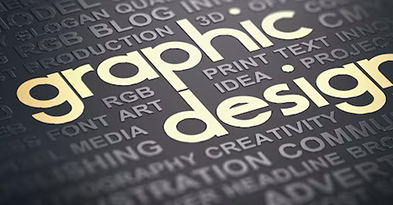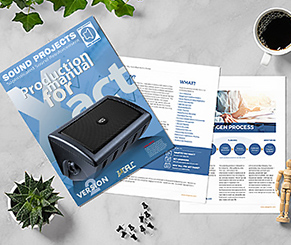Graphic Design
Graphic Design encompasses a wide range of applications, far beyond the familiar areas of corporate identity, marketing or logo development. It also plays a crucial role in the design and development of products, including audio-related technologies. During the early stages of concept development, comprehensive reports are required to visualize not just the product design, but also the strategic and marketing direction post-production.
For manufacturing processes to run smoothly, a detailed and accurate Production Manual is essential. This includes high-quality, technical graphics that clearly outline every procedure. At the same time, we continue to offer professional graphic design services for more traditional projects. Our graphic designers specialize in crafting minimalist, timeless visuals that maintain their relevance over time. No matter the scope or purpose, we create exclusive, custom-tailored graphics that meet your specific needs, across all applications.


Engineering Graphic Design involves translating technical concepts into visual representations to enhance understanding of how a system works or appears. These visuals may range from precise CAD drawings to explanatory infographics that illustrate specific operational principles. Their main purpose is to simplify complex ideas and present them in a clear, step-by-step manner. Throughout the product development process, it’s essential to create comprehensive documentation supported by graphics. This not only guides the development path but also fosters effective brainstorming in a multidisciplinary engineering environment.
When a product moves into the manufacturing phase, a detailed Production Manual becomes crucial. This manual outlines all procedures and technical specifications required for production. Manufacturers use this documentation to establish a structured approach to serial production. We develop the Production Manual in close collaboration with all engineers and developers involved, ensuring a high-quality final product.
Conventional Graphic Design focuses on visuals used for a wide range of purposes beyond the technical realm. These designs often serve marketing objectives or provide user instructions for products aimed at end users or consumers. To maintain clarity and relevance, certain graphic conventions must be followed. Most importantly, the designs should be minimalist and direct. While elaborate visuals may initially seem impressive, they often risk causing confusion.
It’s also essential to consider the cognitive abilities of individuals who may not have technical knowledge. The target audience plays a crucial role in determining how the content should be visually presented. Our designers are experienced professionals who craft visuals tailored to resonate with the intended audience, ensuring their relevance both now and in the future.
Marketing Graphic Design focuses on creating visual content and assets specifically for marketing and advertising purposes. It combines core graphic design principles with brand-specific guidelines that define a company's visual identity. Our marketing design specialists bring both creative flair and technical know-how to shape strong brand identities, boost audience engagement, and support the success of campaigns for newly developed products. Their work extends beyond visual appeal; it plays a strategic role in communication, making them key contributors to effective and impactful marketing initiatives.
As you probably know by now, we provide end-to-end development support for audio products, but also with a strong focus on integrating high-quality graphic design into engineering workflows. From early prototypes to final production tools and jigs, our visual and interface design capabilities ensure that every product touchpoint - whether on-device, on-screen, or within test and diagnostic systems - is both highly functional and visually aligned with your brand. This design-driven approach improves clarity, streamlines processes, and supports engineering teams during development as well as operators on the production floor. Our work is structured around the following four core service domains:
█ 1. User-Centered Design
We craft intuitive, on-brand user interfaces and marketing websites that captivate stakeholders and end users alike, ensuring your product’s story is told clearly across web, desktop and embedded screens.
█ 2. Custom Software & Automation
Bespoke server applications and real-time monitoring tools power your R&D testing workflows and production lines; reducing manual steps, streamlining data analysis and slashing time-to-insight.
█ 3. Process-Control Engineering
From automated quality-control dashboards to live-alert systems, we embed robust safeguards into every stage of your manufacturing cycle, so defects are caught before they propagate.
█ 4. Embedded Systems & Hardware Integration
We develop product-specific firmware, hardware jigs and test fixtures that tie your mechanical, electrical and software subsystems together; eliminating integration headaches and ensuring a rock-solid pilot phase.
By uniting disciplines like graphic design, front-end UX, back-end software and embedded engineering under one roof, we empower you to:
● Accelerate development timelines by up to 30%.
● Elevate product quality through zero-defect process controls.
● Ensure a consistent, on-brand UI experience from lab prototype to production.
█ Research
The Research phase lays the foundation for the project by creating a clear development roadmap that ensures an efficient workflow and a high-quality outcome. We begin with a client discovery process to define your goals, understand your target audience, position your brand across both digital & physical platforms and identify technical requirements.
█ Concept
With the research complete, we translate our findings into a comprehensive client brief, including content architecture, technical specifications, and wireframes. We also provide strategic suggestions to enhance the impact of your content and improve the overall user experience.
█ Development
Once the structure and direction have been finalized, we move into the design phase. Our creative team develops a unique visual framework tailored to your company’s message, while also aligning with the marketing strategy to effectively reach your target audience.
█ Delivery
After successful testing and final client approval, we proceed with the project launch. Post-launch, we hand over the operational control and maintenance to your team, complete with product training. The marketing strategy developed during the process is then activated to support visibility and growth.
Once a product has been manufactured, it requires packaging that not only provides optimal protection during transport, but also reflects the product’s aesthetic appeal and resonates with its target audience. Effective packaging design is inherently multidisciplinary, combining functionality with visual impact. Most importantly, it ensures the product reaches consumers in perfect condition.
The packaging must also preserve the product’s performance throughout distribution, preventing any compromise to its structure or functionality. The same level of care invested in manufacturing should be evident in the packaging, achieved through thoughtful, durable and visually consistent design. Our team of designers works closely with you to create packaging solutions that deliver maximum protection while elevating your product’s presentation.
More Specifics...
The visual & graphic design work that supports high-end audio and automation systems is more involved than we can fully capture here. From user interface layouts and brand consistency to packaging, typography and iconography: every element contributes to a seamless user experience and strong identity. If you're interested in how we handle graphic design for professional-grade products, or want to discuss specific creative directions, feel free to reach out by phone or email.
Measurable operational improvements
An analysis of the project results and underlying KPIs shows that 92% of our projects met their development timelines, an improvement compared to previous years. This indicates that the ongoing adjustments to process optimization and team integration are having a positive impact. We remain focused on further improving our working methods to ensure your product is delivered on schedule.
WITHIN DEADLINE
PROJECT TEAM
ENGINEERING